Let me just throw it out there. I’ve had a few so-called “orange wines” over the years and couldn’t stand them. I was seriously like what it this sour tasting abomination?! How could people drink this crap?! But like any good wine fiend lover, I never write off a wine and will continue to re-taste it over time – well, except maybe Pinotage. I mean palates do change and evolve and mine certainly is no exception.
Though not really new,1 the last few years have certainly seen orange wine becoming more pervasive in wine culture. But before we really dig in, let’s be clear on a couple of points. Yes it can be a pretty orange color and instantly makes you think of all of the pretty pink wines out there, but it is NOT a replacement for Rosé. In fact, these wines are very different from Rosé wines. Second, it is not made with orange juice (just in case there was any confusion). Orange wines are made from white grapes. And that orange color results when the grape skins are fermented or macerated for weeks or even months with the juice, as opposed to the just pressing the grapes, quickly removing the skins, and fermenting the juice alone. So a more accurate term for these wines, and one you’ll see the sticklers (who hate the phrase ‘orange wine’) using, is skin-fermented or skin-contact wine.
So basically, orange wine is made like red wine and like red wines, the skin contact provides the wine with pigment, body, flavor, tannin, and structure. The depth of the orange hue as well as the intensity of the flavors, depends on how long the skins ferment with the juice which can be hours, days, or even months. Unlike red wines, the skin contact for white grapes can produce qualities from undesirable to downright nasty (IMHO). But it can also produce some of the most versatile, interesting wines around.
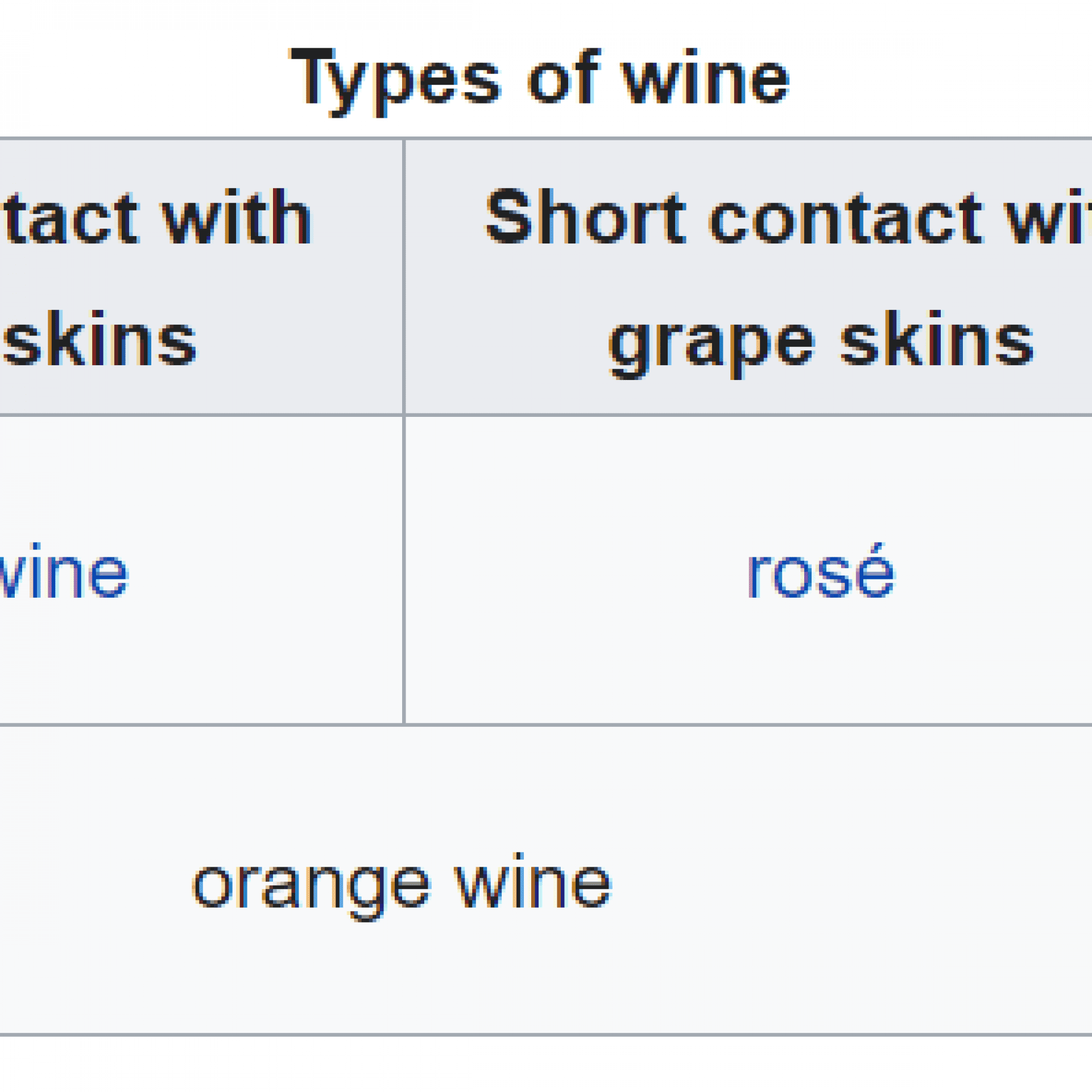
What I have learned in tasting a few of these wines is that I’m not a fan of the ones with the extended skin contact as the flavors are just too intense for me and border on an almost a sour beer taste. Of course, I’ll keep trying them as I come across them. But so far, I lean towards the versions with lesser amounts of skin contact.
So what’s the deal? Why drink these wines if they can be unpredictable or off-putting? Part of it is definitely a “wine geek” thing, at least initially, but the wines are becoming more mainstream. And if you’re into so-called “natural wines”2 many of these wines tend be made with little intervention – no chemical additives or “other stuff,” native yeasts, and/or are unfiltered. But what I find interesting about them is their pairing versatility. These wines can fill the gaps where pairing can be difficult as well as cross the wine spectrum. It can be a ready substitute for things you may pair with a red wine or where certain whites or even rosé may be overpowered. Similarly, where a red wine would be too much and nothing but the most robust white wine will do, orange wines can be a ready substitute. And if nothing else, it gives you another interesting option rather than the same old things you normally drink.
To test this versatility, I tried two orange wines side by side with three different dishes.
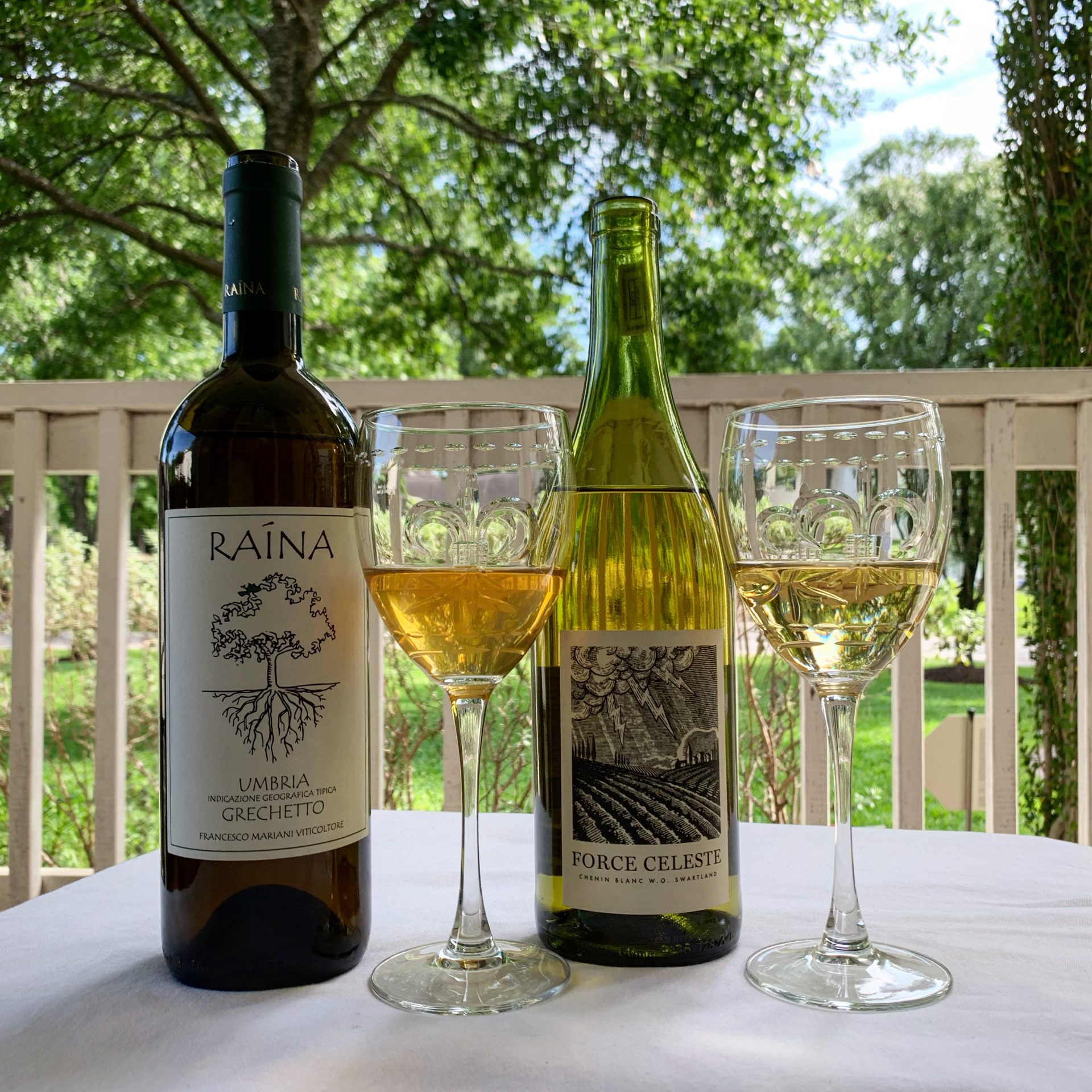
On the spectrum of orange wines, these were of the lighter skin-contact variety which provides less of the “funk” and oxidation that you sometimes get with these wines. The three dishes we paired were yellow curry lamb, mushroom risotto, and crab cakes.
2018 Francesco Mariani Viticoltore Raína Grechetto, Umbria, Italy.
This Grechetto hails from Umbria,3 which is one of those regions that is often overshadowed by rockstar neighbor Tuscany. It is fermented with indigenous yeasts and aged in stainless steel on the lees. A little sour funk, peach, and honey on the nose with flavors of peach tea, dried orange peel, and a bit of nuttiness along with a somewhat tannic, bitter finish. I wouldn’t necessarily drink this alone, but man, I loved it with food. So what did it pair well with?
It was easily the better pairing wine for the yellow curry lamb. Here we were pairing two things with bold flavors and each could match the other’s intensity. Acidity alone wasn’t enough, which is what the Chenin brought to the table. The bolder, fuller-bodied Grechetto with acidity matched the weight and intensity of the lamb. I absolutely loved this pairing.
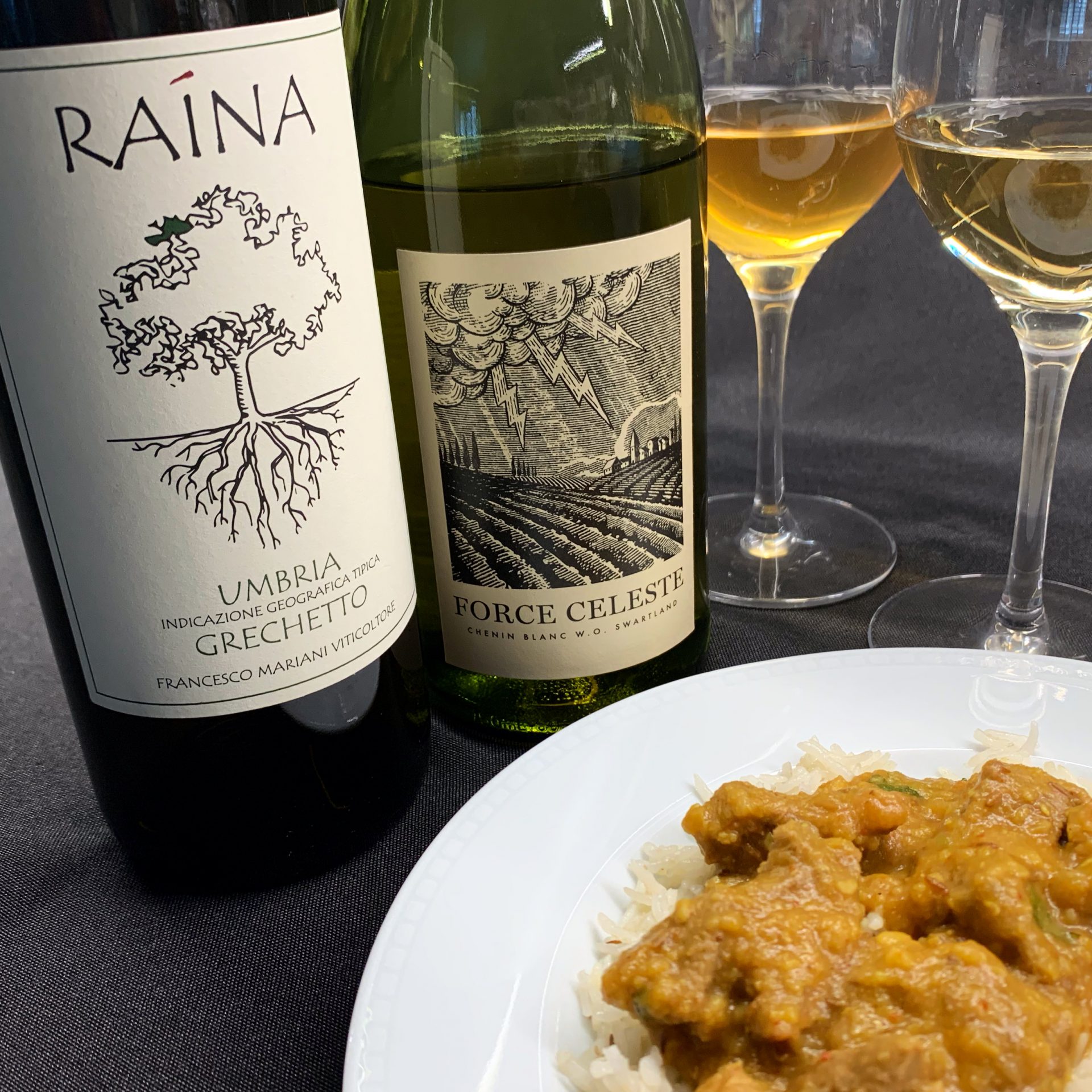
Though this one was closer, the Grechetto was also a better paring with the risotto. Mushroom risotto is one of my favorite meals (alas, the rest of the family doesn’t love it as much as I do), and it was a natural with the Grechetto. Like the curry, the bold umami flavors from the mushrooms needed a bolder wine. Normally I would reach for Nebbiolo or Pinot Noir with this dish, but the Grechetto had enough weight and was a great pairing.
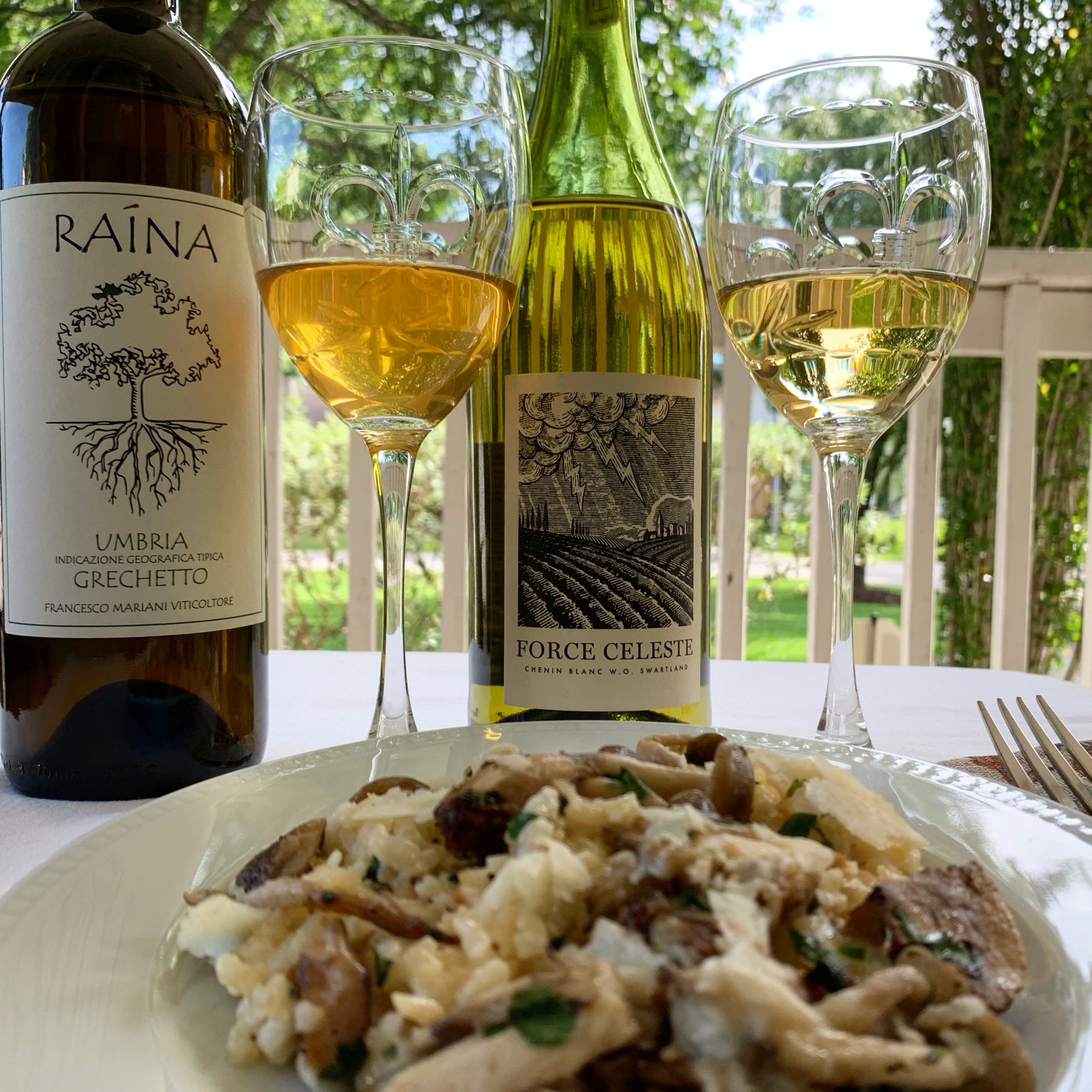
With respect to the crab cake, I thought the Grechetto was a bit much for this dish. Even with a pan sear, the crab cake needed a more delicate wine. But overall, the structure and a acidity of the Grechetto allowed it to pair with heavier dishes that may have been overpowered by a red wine, but too much for a white wine to handle.
2019 Mother Rock Force Celeste Chenin Blanc, Swartland, South Africa
In the last few weeks I’ve been drinking more South African wine and though I don’t always love them (looking at you Pinotage!), you can rarely miss me with Chenin Blanc. The name of this one, Force Celéste, comes from the Latin Caelestis meaning “heavenly sky.” The grapes were grown in granitic soils, farmed organically in bush vines, and the wine was made with minimal interference. This was the “milder” of the two wines as only 20% of the juice had skin contact but it still had some slight funk as well as tart lemon, minerals, and a firmer structure than you’d typically find in a Chenin. So with its degree of skin contact, it drank closer to a white wine, but that small bit of skin contact still gave it a little more body and interest. And yeah, since we know what the Grechetto paired well with, we are left with the crab cakes. And given its profile, this was definitely the better paring for the crab. Light to medium bodied wines with high levels of acidity, are great with crab cakes.
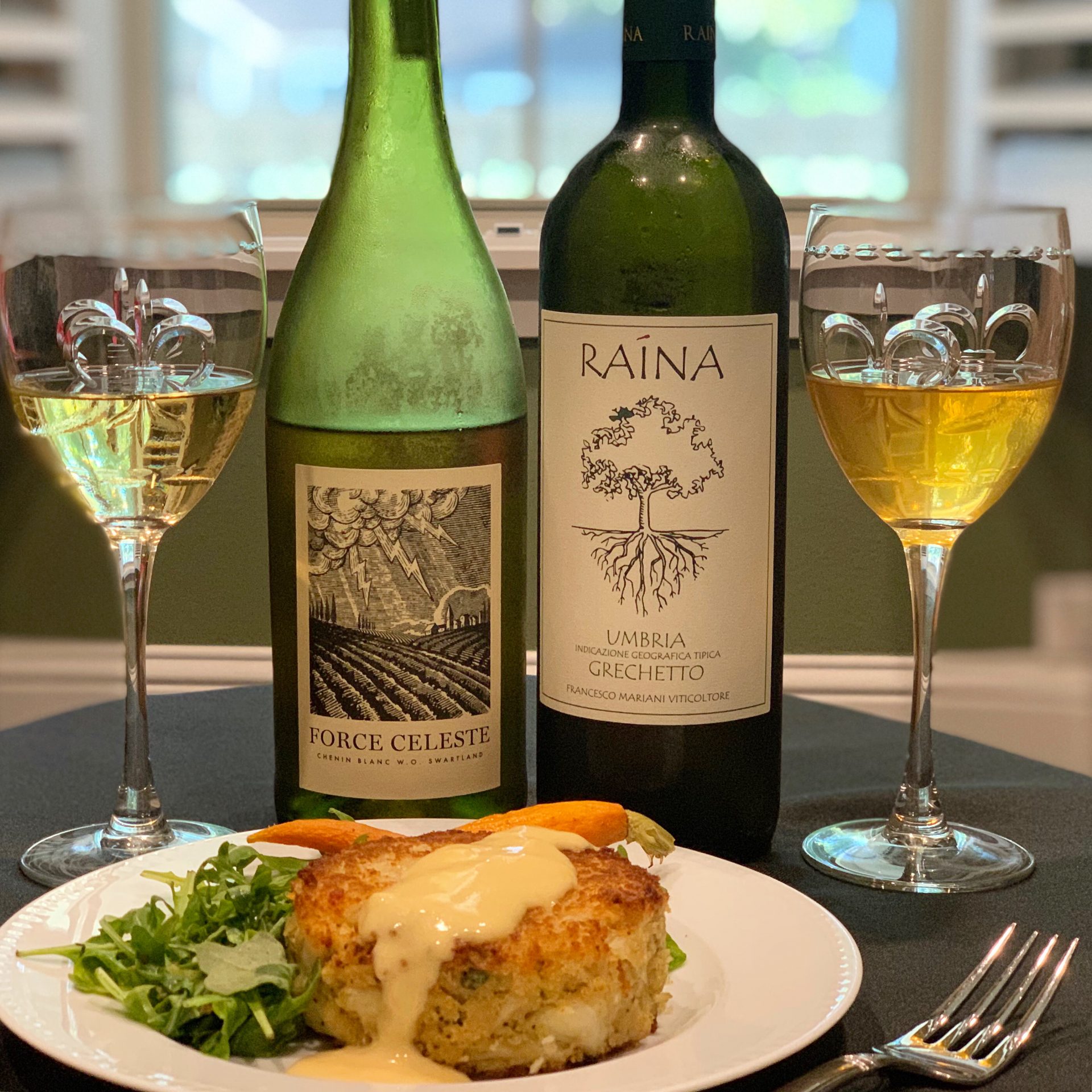
I bought both of these wines at local wine shop Camerata, and I find that these smaller shops are great places to find these types of wines. And if you have any orange wines you think I should try, please let me know.
For more insight into orange wines, including great pairing ideas, check out what my other fellow #WinePW wine bloggers wrote about.
- Camilla of Culinary Adventures With Camilla will be Diving into the Skin Fermented Wine Pool of Two Shepherds Winery.Wendy of A Day in the Life on the Farm presents Donkey and Goat Skin Fermented Roussanne: A Baaaaad Ass Wine.
- Andrea of The Quirky Cork takes up Turkish Amber Wines and Fast Food.
- Olivier of In Taste Buds We Trust is Trying Orange and Non-Orange Wine with Jamie’s Kinda Niçoise Salad.
- Lori of Exploring The Wine Glass asks Orange You Glad I Have Wine?
- Jeff of Food Wine Click! offers Wine 201: Orange Wine Primer.
- Jill of L’Occasion has us Thinking Wine: The Engaging World of Orange Wine.
- Linda of My Full Wine Glass is Revisiting NY Finger Lakes Skin-Contact White Wines.
- David of Cooking Chat proffers Cauliflower Bacon Spread with Amber Wine from Georgia.
- Gwendolyn at Wine Predator will be featuring Orange Wines from California and Italy by Accident and On Purpose Paired with Shrimp Curry.
- Lauren at The Swirling Dervish posts He Said, She Said: Ryme Cellars and the Tale of Two Vermentinos.
- Susannah of Avvinare serves up Orange Wine From Slovenia’s Movia Paired with Homemade Sushi.
- Katrina of The Corkscrew Concierge wonders Is Orange (Wine) the New Everything Wine?
- Nicole at Somm’s Table is Cooking to the Wine: Kabaj Rebula and Chicken with Mushroom Escabeche and Lentils.
- Rupal, the Syrah Queen advises us that Radikon Orange Wine – Not Just For Hipsters.
- Deanna of Asian Test Kitchen offers Logan Wines’ Orange Wine And The Bacon That Changed It All.
- Terri of Our Good Life declares Orange Wine is a Thing.
- Host Martin at ENOFYLZ Wine Blog serves up A Cadre Of California Skin-Contact Wines Paired With Ethnic Fare.
And to answer the question, no, orange wine is not the everything wine. But it sure can cover a lot of ground. Cheers until time.
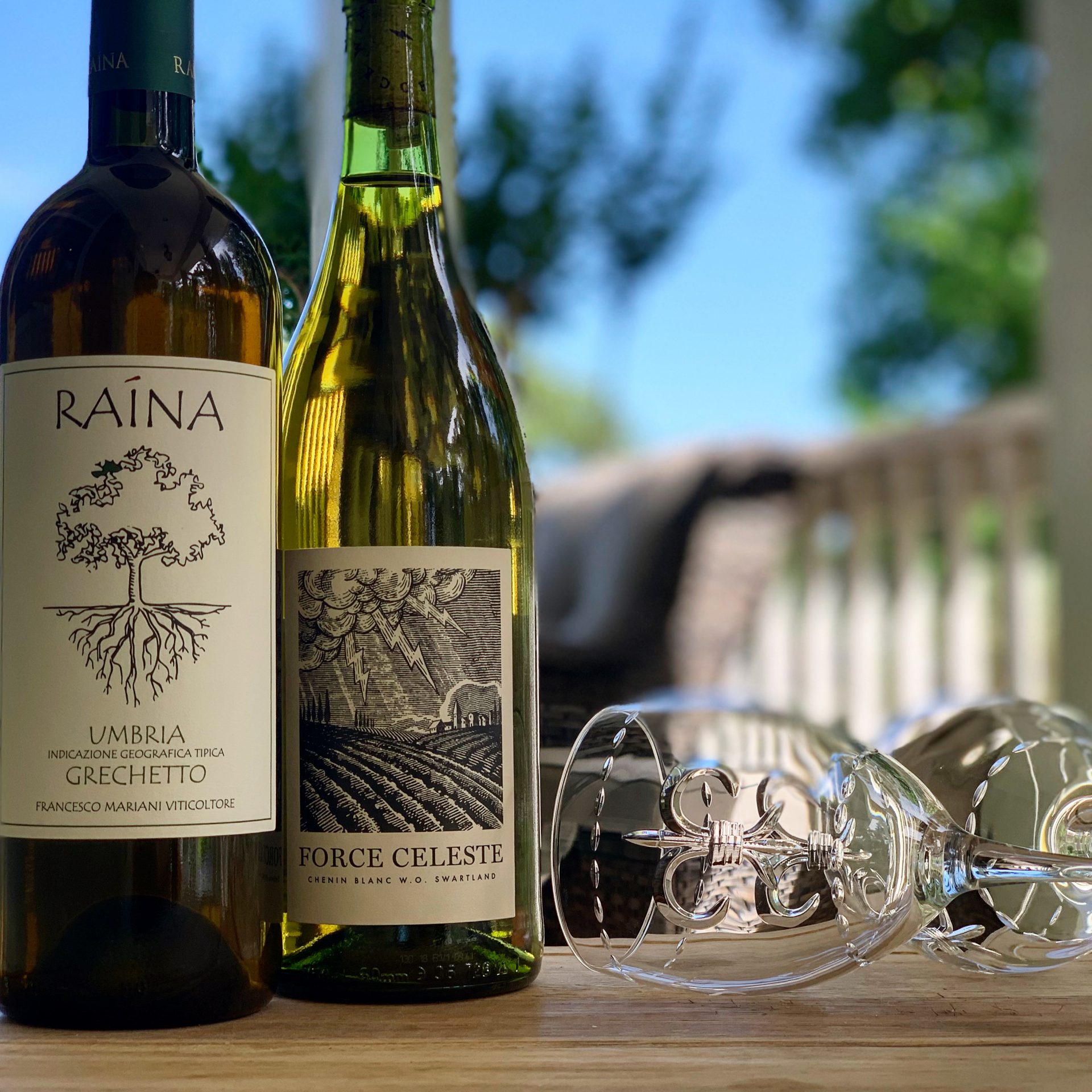
- Skin-fermented wines seemed to have come out of nowhere and was viewed by many as the latest and greatest thing in wine. But in reality, these amber colored wines date back thousands of years in the country of Georgia and have been made for hundreds of years in Italy’s Fruili-Venezia-Giulia region as well as in Slovenia which is where I first tasted one – and hated it. This makes it likely the oldest recorded winemaking process in the world.
- Read up on natural wine here if you’re curious.
- For a deeper dive on Umbria and some of its’ great wines, check out my article on some of central Italy’s under the radar wines.

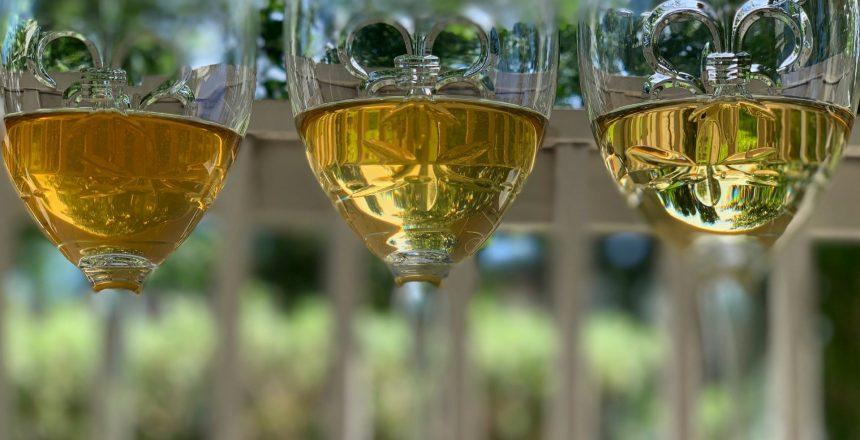
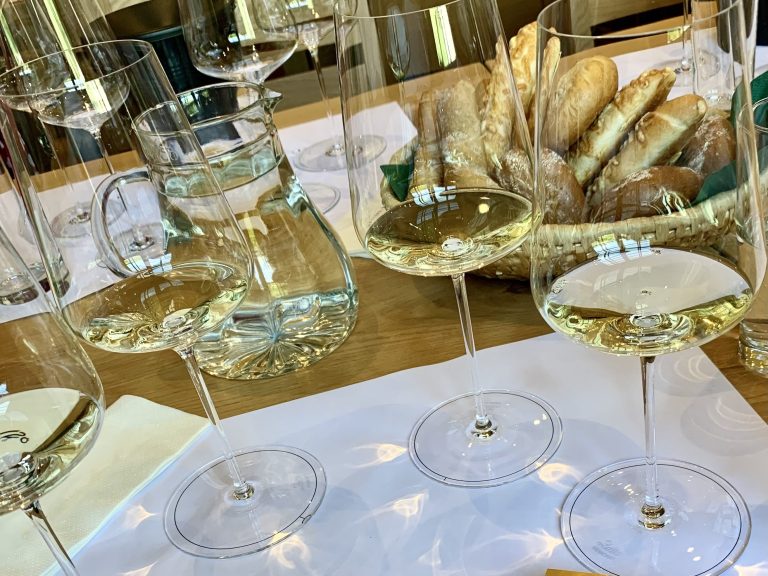



16 Comments
MARTIN D REDMOND
•4 years ago
A wonderful read Katrina! Have you tried any domestic skin-contact whites? In my experience, they’ve been cleaner (no-faults) wine. A few of my favorite producers include Two Shepherds, Donkey & Goat, Giornata, and Troon. Having said that, I need to try more from the Old World. I think (as you point out) that as they become more mainstream, the overly rustic, flawed, but it’s “natural”, so it’s OK from the early days of skin-contact wines has largely gone by the wayside. Cheers
Kat
•4 years ago
I haven’t had any domestic versions but will definitely seek them out as so many of you seem to be big fans.
Andrea
•4 years ago
What great pairings! That Grechetto especially sounds beautiful.
Kat
•4 years ago
It was such a fantastic food wine.
Lauren Walsh
•4 years ago
I think you’ve summed up how a lot of us feel about orange wines – at least at first! My first few tastes did not endear me to the category; luckily I kept an open mind. I love that you tried a Grechetto. It’s a variety I really dig, so now I’m going to track down a skin-fermented version. Great post!
Kat
•4 years ago
It was definitely something that I had to warm up to.
Olivier
•4 years ago
Hi Kat, I love your no bullshit take on these wines! After my own experience I guessed that the lamb would be the better match with the Grechetto, and it was. You see, we learn alot from these experiments! 🙂
Kat
•4 years ago
Ha ha! And yes, these are definitely the best kinds of experiments.
Lori
•4 years ago
love that we can experiment and learn from our wine pairings! Its the best type of education
Linda Whipple, CSW
•4 years ago
That added body in skin-contact whites does make them interesting! Love the experimentation and vivid description of the results. Thanks!
Jeff Burrows
•4 years ago
I’m glad you found some skin-fermented wines you like. They’re certainly not for everyone! I’ve enjoyed the Raina Grechetto on a number of occasions here in Minnesota.
Deanna
•4 years ago
All that food you made looks so scrumptious and better than a restaurant! Love the pairings you chose and wines you found. I also get mine from a local, independent wine shop that I love.
Jeanne Savelle
•4 years ago
Kanonkop Pinotage – perfectly beautiful
Kat
•4 years ago
I’ve seen that one but never tried. Will have to give a whirl. Thank you for the recommendation.
Nicole Ruiz Hudson
•4 years ago
I totally get you on needing to warm to these wines. (In my post I describe my hubby’s evolution with them which is very similar to yous. LOVE the idea of the Grechetto with the lamb curry! And I am 100% with you on Pinotage.